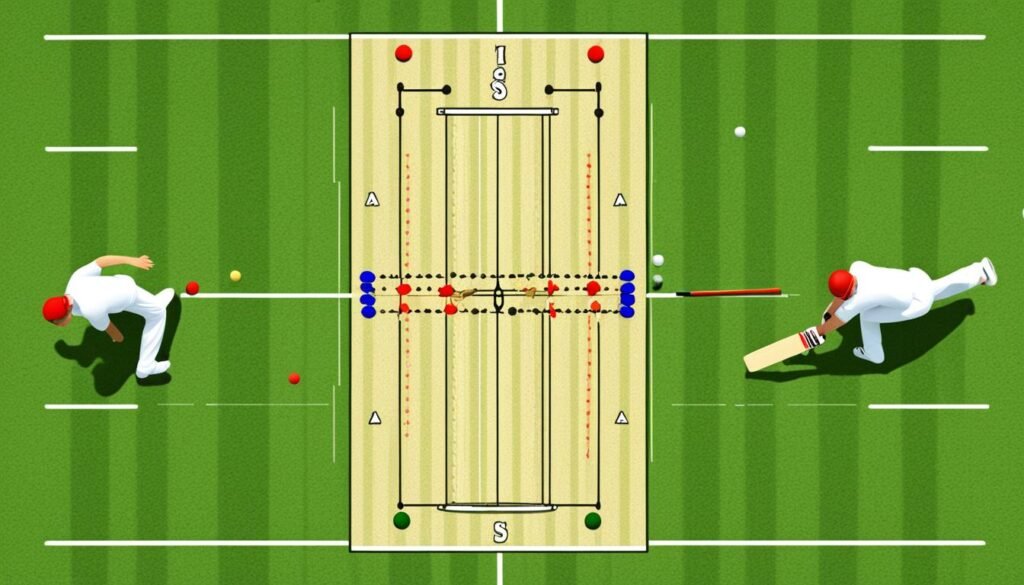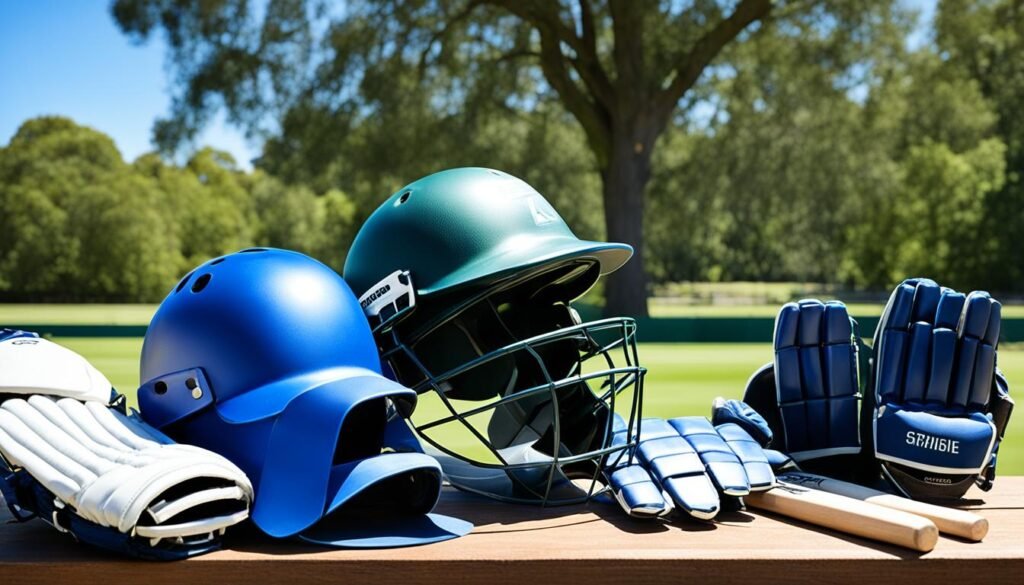Cricket is a captivating sport that requires a combination of skill, strategy, and dedication. Whether you’re a beginner or an experienced player, honing your cricket techniques is essential for improving your overall game. In this article, we will explore various aspects of cricket, including batting skills, bowling strategies, fielding techniques, and cricket coaching tips to help you elevate your performance on the field.
Key Takeaways : Cricket Technique
- Mastering cricket techniques is crucial for improving your game.
- Focus on improving your batting skills, including stance, grip, footwork, and shot selection.
- Discover effective bowling strategies and work on delivering a variety of deliveries with accuracy.
- Enhance your fielding techniques, from agility to catching and throwing accuracy.
- Seek guidance from experienced cricket coaches to refine your skills and learn effective cricket strategies.
By dedicating time and effort to mastering these cricket techniques, you can elevate your game and make a significant impact on the field. Whether you aspire to compete at a professional level or simply want to enjoy the sport to the fullest, improving your cricket skills is a rewarding journey that offers endless opportunities for growth and success.
History of Cricket: An Evolution of Cricket
Cricket, a sport with a rich history, traces its origins back to the 16th century in England. Over the years, it has evolved and gained popularity across the globe, capturing the hearts of millions of fans. The game has witnessed significant developments, culminating in prestigious international tournaments like the Cricket World Cup.
International Cricket Council (ICC), the governing body of the sport, was established to oversee and nurture cricket’s growth and evolution in different countries, ensuring fair play and promoting the spirit of the game.
“Cricket, like any other sport, has evolved over time. It has grown from its humble beginnings to become one of the most beloved and followed sports globally. The journey of cricket is fascinating, reflecting the resilience, passion, and skill of the players who have made the sport what it is today.”
Cricket’s history is marked by significant milestones, including the first-ever recorded match in 1697, the establishment of the Marylebone Cricket Club (MCC) in 1787, and the inaugural Cricket World Cup held in 1975. The world cup has since become a highly anticipated event, showcasing the top cricketing nations as they compete for glory on cricket’s biggest stage.
As the sport continues to evolve, it has witnessed the emergence of different formats, such as Test cricket, One Day Internationals (ODIs), and Twenty20 cricket. Each format brings its unique challenges and appeals to different audiences, contributing to cricket’s continuous evolution and popularity.
Understanding the history of cricket is crucial for appreciating the roots of the sport and how it has transformed into a global phenomenon. By delving into the past, we gain insights into the game’s evolution, the legends who have graced the pitch, and the milestones that have shaped cricket’s storied history.
Basics of Cricket: Strategies and Techniques
Cricket is a complex sport that requires a deep understanding of the game’s laws and various techniques. Whether you’re a beginner or an experienced player, mastering the basics is essential for honing your cricket skills and achieving success on the field.
Cricket Basics
To excel in cricket, it’s important to have a solid grasp of the fundamentals. This includes the rules of the game, such as how runs are scored, getting the opposing team out, and the different positions on the field. It’s also crucial to understand the equipment used in cricket, from bats to balls to protective gear.
Cricket Strategies
Cricket is not just about physical prowess; it requires strategic thinking and decision-making. Developing effective cricket strategies can give you an edge over your opponents. This includes planning batting orders, fielding placements, and bowling tactics based on the specific conditions and strengths of your team and the opposition.
Cricket Tactics
Mastering cricket tactics involves honing your skills in batting, bowling, and fielding. Improving your batting technique involves perfecting your stance, grip, footwork, and shot selection. As a bowler, you’ll need to work on your run-up, delivery variations, accuracy, and understanding different bowling tactics. Fielding requires agility, communication, precision throwing, catching, and diving to save runs and dismiss batsmen.
As the game of cricket continues to evolve, newer formats like Twenty20 cricket present new challenges and opportunities for players. Adapting your strategies and techniques to these formats can help you excel in the ever-changing landscape of the game.
“Mastering the basics of cricket and developing effective strategies and tactics are essential for success in this intricate sport.” – Cricket Coach, John Smith

| Cricket Basics | Cricket Strategies | Cricket Tactics |
|---|---|---|
| Understanding the rules | Planning batting orders | Perfecting batting technique |
| Scoring runs | Developing fielding placements | Honing bowling skills |
| Getting the opposing team out | Adapting strategies to different conditions | Ace fielding techniques |
| Knowing fielding positions | Utilizing bowling tactics | Enhancing throwing accuracy |
Importance of Physical and Mental Fitness
Physical and mental fitness are vital aspects of a cricketer’s performance on the field. In order to excel in the game of cricket, players must prioritize their overall fitness and well-being. This includes maintaining a healthy physique, developing specific cricket skills, and fostering mental strength to overcome challenges.
“A fit body means a fit mind. Cricket is a physically demanding sport that requires agility, strength, and stamina. Without proper fitness, players may struggle to endure long matches, face fatigue, or even risk injury.”
Cricket coaching plays a crucial role in developing physical fitness and honing specific cricket skills. Coaches guide players in implementing effective training routines, emphasizing the importance of strength, endurance, and flexibility. Through structured practice sessions and targeted workouts, players can improve their cricket-specific fitness and enhance their overall performance on the field.
Mental strength is equally important in cricket as it helps players stay focused, handle pressure, and make accurate decisions in high-pressure situations. Mental resilience allows players to bounce back from setbacks, maintain composure, and perform at their best.
“Cricket is not just a physical game; it is a mental battle as well. The ability to stay calm under pressure, overcome self-doubt, and make strategic decisions is what sets exceptional players apart.”
The Marylebone Cricket Club (MCC) has been at the forefront of promoting cricket fitness and coaching. As the custodian of the laws of cricket, the MCC emphasizes the importance of physical and mental preparation for players at all levels.
Developing good weight distribution, proper footwork, and mastering basic cricket skills are essential components of cricket fitness and coaching. These aspects enable players to react quickly, maintain balance, and execute their shots with precision.
To summarize, in order to succeed in cricket, players must prioritize both their physical and mental fitness. Through consistent practice, proper coaching, and a focus on skill development, cricketers can enhance their performance on the field and unlock their true potential.

Rules of the Cricket Match: Ultimate Guide
Cricket is a sport with intricate rules that may appear overwhelming to newcomers, but understanding the fundamentals is vital to enjoying the game. Let’s delve into some of the key rules that govern cricket matches, including scoring runs, dismissing the opposing team, and the different positions players assume on the field.
Scoring Runs in Cricket
One of the primary objectives in cricket is to score runs. This can be achieved in several ways:
- Batting: Batsmen score runs by hitting the ball and running between the stumps. Each time they successfully complete a run, they add to their team’s total score.
- Boundaries: When the ball hits or crosses the boundary without bouncing, the batting team is awarded four runs. If the ball clears the boundary on the full, without touching the ground, it results in a six.
Getting the Opposing Team Out
In cricket, the objective for the bowling team is to dismiss the opposition. This can be achieved in various ways:
- Bowled: If the bowler’s delivery hits the wickets, dislodging the bails, the batsman is considered out.
- Caught: When a fielder catches the ball, and it hasn’t bounced before being caught, the batsman is dismissed.
- LBW (Leg Before Wicket): If the ball would have hit the wickets but instead hits the batsman’s leg in front of them, the umpire may declare them out if certain criteria are met.
- Run Out: If a fielder successfully hits the stumps with the ball before a batsman completes a run, the batsman is run out.
- Stumped: A batsman is stumped if they step out of their crease while attempting a shot, and the wicketkeeper removes the bails.
Positions in Cricket
Cricket is played with eleven players on each team, and each player has a specific position to fulfill. Here are some of the critical positions in cricket:
| Position | Description |
|---|---|
| Batsman | The primary role is to score runs for the team by facing the bowlers. |
| Bowler | Bowlers deliver the ball to the batsmen with the aim of dismissing them. |
| Wicketkeeper | The wicketkeeper stands behind the stumps and is responsible for catching the ball, stumping, and providing vocal guidance to the fielding team. |
| Fielder | Fielders are positioned in key areas to prevent the batting team from scoring runs by stopping the ball and attempting run-outs and catches. |
| Captain | The captain serves as the on-field leader, making strategic decisions and coordinating the team’s efforts. |
Understanding the rules of cricket is essential for both players and fans. By familiarizing yourself with these rules, you can fully appreciate the nuances of the game and engage in conversations about cricket with confidence.

Gear Required for Mastering Cricket
Cricket players require specific gear to protect themselves and enhance their performance. The right cricket gear not only ensures safety on the field but also maximizes a player’s potential. Let’s take a look at some of the essential cricket equipment:
Helmets
Cricket helmets are crucial for protecting the head against fast bowlers and hard-hitting shots. They are designed to absorb impact and reduce the risk of head injuries.
Bats
A quality cricket bat is essential for mastering the art of batting. It should have the right weight, balance, and grip to enable powerful shots and precise control.
Gloves
Cricket gloves provide protection to the hands while catching, batting, and wicketkeeping. They have padded palms and reinforced finger sections to reduce the risk of injuries.
Leg Pads
Leg pads, also known as batting pads or shin guards, protect the legs of the batsman from fast deliveries. They are worn to shield the knees, shins, and thighs from potential impact.
Protective Equipment for Wicketkeepers
Wicketkeepers require additional protective gear, including gloves with reinforced webbing and padded inner gloves, chest guards, and abdominal guards. These gears ensure safety while performing their role behind the stumps.
Proper gear is crucial to protect yourself and enhance your performance in cricket. Remember, safety should never be compromised!

Investing in high-quality cricket gear is an investment in your safety and success on the cricket field. Make sure to choose gear that fits well, offers adequate protection, and is comfortable to wear.
Essential Skills of a Cricketer
A successful cricketer must possess a range of essential skills to excel in the sport. Let’s explore the key skills required in cricket, including batting, bowling, and fielding.
Batting Techniques
Improving batting skills is crucial for a cricketer’s success. Here are some essential techniques that every batsman should focus on:
- Stance: Maintaining a balanced and relaxed stance is essential for better shot execution.
- Grip: A correct grip ensures proper control over the bat and enables a wider variety of shots.
- Footwork: Agile footwork allows batsmen to adjust to different deliveries and find the best position to play the shot.
- Shot selection: Making wise shot selections based on the delivery and field placement ensures scoring opportunities while reducing the risk of dismissal.
- Mental focus: Developing mental strength and focus helps batsmen stay composed and make confident decisions.
Bowling Skills
Bowling skills are equally critical in cricket. Here are the key aspects of bowling that every cricketer needs to work on:
- Grip: A secure grip on the ball enables bowlers to control the swing, seam movement, or spin based on the chosen delivery.
- Run-up: A consistent and efficient run-up sets the foundation for a smooth and powerful bowling action.
- Variety of deliveries: Mastering a range of deliveries, including fast bowlers’ pace, spinners’ variations, and swing bowlers’ movement, gives the bowler an edge over the batsman.
- Accuracy: Delivering the ball with precision and hitting the desired spot consistently is crucial for restricting the batsman’s scoring opportunities.
- Field placement: Setting the right field placement helps create pressure on the batsman and encourages them to play shots that favor the bowler.
Fielding Techniques
Fielding skills contribute significantly to a cricketer’s overall performance. Here are the essential fielding techniques every player should develop:
- Agility: Being quick on the feet and flexible allows fielders to move swiftly and cover more ground.
- Communication: Effective communication between fielders is crucial for better coordination and avoiding misunderstandings during catches, run-outs, or boundary saves.
- Throwing accuracy: Precise and strong throws towards the wicketkeeper or stumps put pressure on the batsman and result in run-out opportunities.
- Catching: Developing safe and consistent catching techniques enhances a player’s ability to grab difficult chances and hold on to the ball securely.
- Diving: Diving saves, both at the boundary and in the infield, can prevent boundaries and create opportunities for catches or run-outs.
Constant practice and improvement in these areas are essential for cricketers to enhance their skills and contribute to their team’s success.
The Role of Umpires in Cricket
In the game of cricket, umpires play a vital role in ensuring fair play and upholding the integrity of the sport. They are responsible for implementing and enforcing the cricket rules, making decisions on various aspects of the game, and ensuring that both teams have an equal opportunity to compete.
Cricket umpires are appointed to oversee matches at all levels, from recreational games to international tournaments. Their main objective is to ensure that the game is played in accordance with the established rules and regulations.
One of the key roles of cricket umpires is to determine whether a batter is out. They make decisions on different modes of dismissal, such as bowled, caught, stumped, lbw (leg before wicket), and run-out. Umpires carefully observe the actions on the field and make impartial judgments based on their expertise and knowledge of the game.
Additionally, umpires are responsible for calling no-balls and wides. A no-ball is called when a bowler oversteps the front line or delivers an illegal delivery. A wide is called when a bowler delivers a ball outside the batsman’s reach. Umpires use their discretion to determine whether these infractions have occurred, and they signal them accordingly to ensure that the rules of the game are followed.
Another crucial aspect of an umpire’s role is to ensure fair play between the teams. They monitor the conduct of players, intervene when necessary to prevent any unsportsmanlike behavior, and promote a respectful and competitive atmosphere on the field.
“The umpire is there to uphold the cricket rules and act as a guardian of fair play. They play a crucial role in the game, ensuring that it is played within the spirit of the sport.”
Overall, cricket umpires contribute significantly to the overall fairness and integrity of the game. Their decisions and actions are essential in maintaining the balance between teams and upholding the principles of fair play. Without umpires, the game of cricket would lack the necessary oversight and guidance needed to ensure a level playing field for all teams involved.
Understanding the basic rules of cricket involves mastering cricket batting technique, which is crucial for scoring runs and defending the stumps. When the ball is pitched, it’s important to decide whether to play forward or back, using a side-on stance and bringing the bat down in a horizontal arc. Different types of shots can be played, including defensive strokes and aggressive drives, depending on the bowler’s delivery. Whether facing fast bowlers or spinners, it’s essential to watch the ball closely and maintain a relaxed but ready posture.
As the bowler releases the ball, focus on the movement and decide whether to play the shot. Practice makes perfect in cricket, as players aim to score as many runs as possible while staying in the correct position to play each delivery. Always remember to keep the front shoulder facing straight towards the bowler and the feet shoulder-width apart. Whether it’s facing a bouncer or a yorker, being able to play any shot is key to success in the cricketing format.
Also Read : Discovering The Hidden Gems Of Cricket’s Past
| Role of Umpires in Cricket | |
|---|---|
| Implement and enforce cricket rules | Ensure fair play |
| Make decisions on modes of dismissal | Call no-balls and wides |
| Promote respectful and competitive atmosphere | Uphold the integrity of the sport |
Conclusion
Cricket is not just a sport; it is a combination of physical prowess, mental agility, and strategic thinking. Whether it’s the artistry of batting, the precision of bowling, or the finesse of fielding, every aspect of the game is essential in determining a team’s success.
It is crucial for cricket players to continuously refine their skills and techniques to adapt to the ever-evolving nature of the game. By dedicating themselves to constant improvement, players can unlock their full potential and enjoy the thrill of this remarkable sport.
Cricket is a game that rewards discipline, teamwork, and perseverance. The skills acquired on the cricket pitch also translate into valuable life lessons, like resilience, decision-making, and effective communication.
So, whether you’re a budding cricketer or a fan of the game, embrace the challenges, celebrate the victories, and immerse yourself in the beauty of cricket— where skill, technique, and the love for the game intertwine.
FAQs
Q: What is the importance of having a proper batting stance in cricket?
A: Having a correct batting stance in cricket is crucial as it helps in maintaining balance and allowing the player to move quickly in any direction to defend or attack the ball.
Q: How can footwork impact a batsman’s performance?
A: Good footwork is essential in cricket as it enables the batsman to position themselves correctly for different types of shots and helps in maintaining balance while playing the ball.
Q: What is the significance of backlift in cricket batting technique?
A: Backlift is important as it helps in generating power and momentum for the shot, allowing the batsman to strike the ball effectively and with control.
Q: Why is it essential to watch the ball carefully while batting?
A: Watching the ball is crucial in cricket as it helps the batsman to judge the line and length of the delivery, enabling them to make contact and play the appropriate shot.
Q: How does posture affect a batsman’s ability to score runs in cricket?
A: Maintaining the correct posture while batting is essential as it allows the batsman to move freely, maintain balance, and execute shots with precision, ultimately helping them to score more runs.
Q: What are some common drills to improve batting technique in cricket?
A: Some common drills include practicing batting against a bowling machine, focusing on specific shot selection, and working on footwork and timing through repetitive practice sessions.
Q: How can a batsman improve their ability to play different types of shots in cricket?
A: Batsmen can improve their shot-making ability by practicing various batting styles, mastering the placement of the bat, and understanding the timing required for different types of shots such as drives, cuts, and pulls.
Source Links
- https://blog.sixescricket.com/tips-for-improving-your-cricket-game/
- https://medium.com/@SeoWritingExpert/cricket-game-techniques-and-strategies-for-master-players-and-enthusiasts-ultimate-guide-8794cf13171c
- https://cricketforall.com.au/8-tips-to-improve-your-cricket-batting-skills/



